|
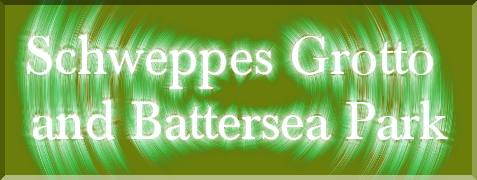
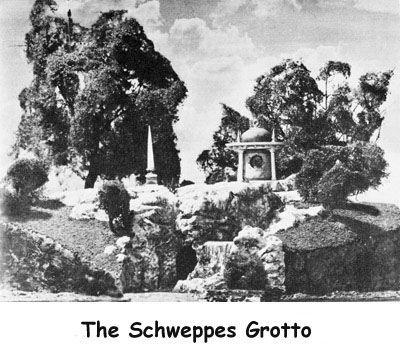 Battersea Park Grottoes including the
Battersea Park Grottoes including the
Schweppes 1951 Festival of Britain Grotto
Battersea
London
United Kingdom
SW11 4NJ
Telephone: 020 8871 7530
The site of Battersea Park before the 1840s was called Battersea Fields. It was open ground and marshland that had been reclaimed from the banks of the Thames. Battersea Fields was a place where produce from outlying areas and local growers, was sold to Battersea's new and burgeoning local slum population.
Pictures above - The model of the Schweppes Grotto by Richard Dendy a model maker at the time supplied by his grandson Jon Hearn. RD made theatrical props, sets for films and architectural models, including the Schweppes Grotto.
Following an 1833 Select Committee report on the benefits of public parks, both for the public's health and their civilising effect. The government initiated a programme of park-building intended to promote in the populace the right qualities of character and outlook so highly prized in Victorian Britain at the time of Empire. Following an 1844 proposal that Battersea Fields be developed as one such site, the government enacted a statute to lay out a Royal Park there. Initially it drew inspiration from a scheme devised by James Pennethorne - who had contributed to the design of Regents Park and would go on to design Victoria Park and Kennington Park. First however, several hundred tons of material was excavated from Surrey Docks to raise the level of the site.
In 1854, the park's first superintendent John Gibson (a former pupil of Joseph Paxton, head gardener to the Duke of Devonshire at Chatsworth and designer of one of the first public parks at Birkenhead) designed and built the defining elements of the park especially the carriage drives, lake and mounding which remain largely unchanged to this day. There followed various landscaping initiatives, including the establishment of a number of rock features by Pulhams of Broxbourne. This company of high repute used their own stone Pulhamite to develop water cascades, grottos and rocky streams. This work was carried out between 1865 and 1870. This made the park, according to some observers, the most romantic spot in or near London. 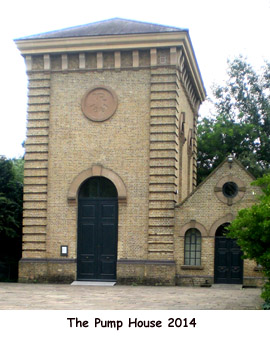 Problems arose however with the water supply to the lakes and water falls from a new Pump House that was constructed in 1861. Problems arose however with the water supply to the lakes and water falls from a new Pump House that was constructed in 1861.
The Pump House is located at point "D" on the map below. The tower was built in 1861 by Simpson and Son to house a coal-fired steam engine and pump that circulated water in the lake, watered the park's plants and drove artificial rockwork cascades situated on the north bank of the lake. For safety reasons, in 1909 the pump tower's smaller adjoining building was built over the well from which the pump drew water. The steam-powered pumping system, although never completely successful, continued to be used until the 1930s.
In 1951 Battersea Park became the Festival Pleasure Gardens and was one of the principal 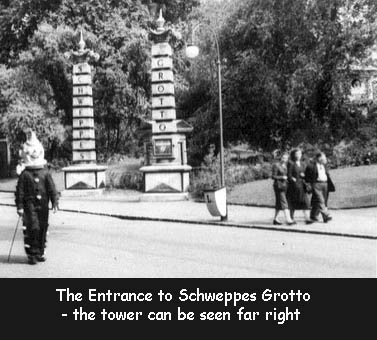 sites for the Festival of Britain, the other key site being the South Bank and Royal Festival Hall. During the run up to the opening a debate ensued in the House of Lords on 23 January 1951 about whether the festival should open on Sundays and how this influenced children with regard to respecting the Sabbath. This caused an interesting question from Lord Strabolgi. sites for the Festival of Britain, the other key site being the South Bank and Royal Festival Hall. During the run up to the opening a debate ensued in the House of Lords on 23 January 1951 about whether the festival should open on Sundays and how this influenced children with regard to respecting the Sabbath. This caused an interesting question from Lord Strabolgi.
"What age limit is there to the use of the underground grotto and the series of other grottoes?"
This comment is interesting because it suggests more than one grotto, a point that needs to be born in mind when identifying the location of the Schweppes Grotto. Eventually the legislation was finalised and Battersea Park was once again transformed, this time with a variety of entertainments and amusements making it one of the first theme parks in the UK. It opened in 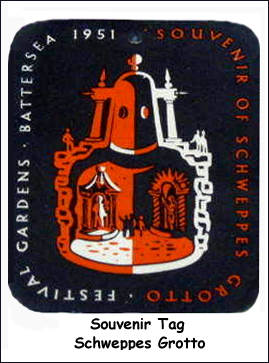 April 1951 and the Schweppes Grotto with its four caves was one of the principal attractions. April 1951 and the Schweppes Grotto with its four caves was one of the principal attractions.
Visitors to the Schweppes Grotto entered the first cave "Air" climbing a circular path, passing niches to the four winds. With the North Wind came the howling of wolves, the scent of pine forests and the jingle of sleigh bells. Next the East Wind where eastern music and temple bells greeted the visitor with the odour of spices. The South Wind came with the sound of tom toms and jungle noises and the scent of flowers. Then the West Wind with the smell of ozone and seaweed, seagulls calling with other sea sounds including fog horns.  The second cave of "Fire" was similarly dramatic. Visitors crossed a bridge over a crater of molten lava, flames lit the walls and smoke was overhead. Then on to the "Earth" cave. Here beautiful minerals were revealed with stalactites glittering in the changing colours. A fountain rose and fell accompanied by the smell of peat moors and music. The fourth cave "Water" was lit by ultra-violet light. You walked through a coral reef with glimpses of sea life including fish and strange creatures. The Schweppes four cave grotto overall was a tremendous visitor attraction and nearly ten thousand pounds was donated to the National Playing Fields Association from entry fees. What we have been unable to ascertain was whether the Schweppes Grotto celebrated 100 years of bottling Schweppes Malvern Water. The second cave of "Fire" was similarly dramatic. Visitors crossed a bridge over a crater of molten lava, flames lit the walls and smoke was overhead. Then on to the "Earth" cave. Here beautiful minerals were revealed with stalactites glittering in the changing colours. A fountain rose and fell accompanied by the smell of peat moors and music. The fourth cave "Water" was lit by ultra-violet light. You walked through a coral reef with glimpses of sea life including fish and strange creatures. The Schweppes four cave grotto overall was a tremendous visitor attraction and nearly ten thousand pounds was donated to the National Playing Fields Association from entry fees. What we have been unable to ascertain was whether the Schweppes Grotto celebrated 100 years of bottling Schweppes Malvern Water.
Some of the festival attractions such as the permanent Fair Ground remained at Battersea Park until the 1970s but during the second half of the 20th century the parkland became neglected and decayed. In 1986 Wandsworth Borough Council took over responsibility for the Park from the London County Council. From 1993 to 1996, jointly funded by Wandsworth B.C. and the European Union, the larger part of the extensive lake perimeter was restored to its Victorian splendour and a vigorous replanting programme set in motion with the aim of reproducing the park's original horticultural beauty.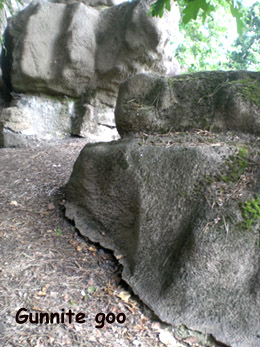 Unfortunately gunnite, a sprayed on concrete, was used to restore the Pulhamite rock features. This led to a loss of aesthetic appearance and English Heritage raised extreme concern. Although weathering and plant growth has today removed some of the worst of the "gunnite goo" appearance, it is still apparent on key features, especially where the surrounding ground level has dropped and the gunnite rim can be seen around the rocks. Unfortunately gunnite, a sprayed on concrete, was used to restore the Pulhamite rock features. This led to a loss of aesthetic appearance and English Heritage raised extreme concern. Although weathering and plant growth has today removed some of the worst of the "gunnite goo" appearance, it is still apparent on key features, especially where the surrounding ground level has dropped and the gunnite rim can be seen around the rocks.
The 1861 pump house and surrounding had also become derelict by the time Wandsworth B.C. took control. Following this, English Heritage and Wandsworth Council worked together on the four hundred thousand pounds restoration project and the Pump House building reopened in 1992 as a shop, Park Information Centre and Art Gallery. As a result, the Pump House Gallery is now a restored grade II listed building.
So where are the grottoes?
Firstly the Schweppes Grotto. This was constructed to promote Schweppes at the Festival of Britain. Inspection of the souvenir tag that visitors to the Schweppes Grotto were given at the Festival of Britain shows that the grotto is depicted as a tower over two caves with steps up the side for visitors. 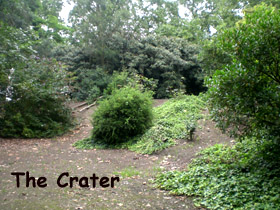 This endorses the identification of the photographs
above of the Schweppes Grotto as a rocky mound with a tower atop. This endorses the identification of the photographs
above of the Schweppes Grotto as a rocky mound with a tower atop.
Close inspection of the first picture also reveals a water cascade to the right of what appears to be a cave entry at ground level.
It is known that Schweppes had four caves in their grotto representing Air, Fire, Earth and Water. Visual, aromatic and sound effects enhanced the experience for visitors. The question arises however where was this grotto located? Inspection of the 1951 Festival Pleasure Gardens layout plan suggests that the grotto is located at point "A" on the map reproduced below.
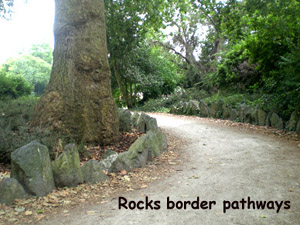
Exploration of this area today reveals a substantial wooded crater surrounded by a bank of about 10 feet high with an access path. Rocks (not Pulhamite) border the paths in this area and may signify former use in a grotto that has now been removed. Also however beneath the undergrowth a number of Pulhamite rocks exist, suggesting that an original rock work by Pulham's existed here. Perhaps Schweppes used the rocks bordering the paths to enhance any original rock grotto that Pulhams had constructed at this location? 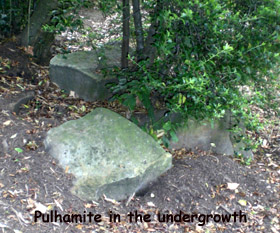 The complexity of the Schweppes Grotto however suggests that a substantial new structure would have been required over and above what was already on the site previously. We assumed the grotto was removed and the area cleared after the Festival of Britain. This was not the case as was apparent from the following testimony from the other side of the world in 2014.
The complexity of the Schweppes Grotto however suggests that a substantial new structure would have been required over and above what was already on the site previously. We assumed the grotto was removed and the area cleared after the Festival of Britain. This was not the case as was apparent from the following testimony from the other side of the world in 2014.
"I spent a lot of time in Battersea Park as a child as we lived locally, it was spectacular, and my sister and I would always go to the grotto, it was free! From my memory it was definitely in the area marked A on the map, if you had asked me to pinpoint on a map without seeing the suggested locations I would have put it there.
I was interested to see that there was a suggestion that the Grotto was removed after the Festival of Britain, this wasn't the case as our visits were in the late sixties, early seventies. I remember the four chambers, especially Air with the North, South, East and West winds and the sound of the wind, I remember the bridge across the molten lava. By this time it had seen better days and though I remember sound effects, I don't remember the aroma effects. Would love to have seen it in all it's former glory as you describe.
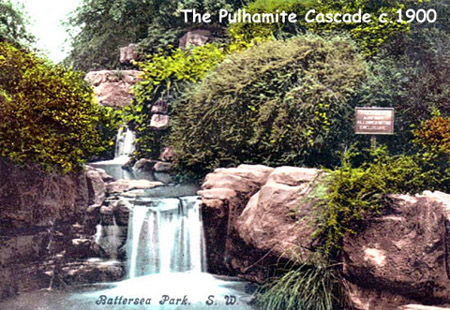 But for me it still remains a magical place, I think many had forgotten about it by the 60's/70's ... It was our little secret.
But for me it still remains a magical place, I think many had forgotten about it by the 60's/70's ... It was our little secret.
Joey Nicholls
The Blue Mountains
Australia."
There are also other grotto like structures in the park that can still be seen. The lake landscape created in the 19th century has a substantial Pulhamite rock feature with a water cascade. This is located at point "B" on the map below. This feature looks remarkably similar to the rock feature in the Schweppes grotto picture referred to above. Today there is no sign of a cave below and the rock work is extensively covered in gunnite goo.
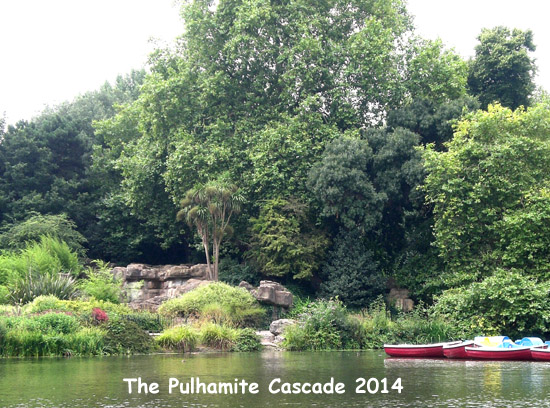
Strangely enough there is a third site of interest marked "C" on the map below. Here there is a Pulhamite small rock cave or grotto. Again the Pulhamite is covered by gunnite goo. 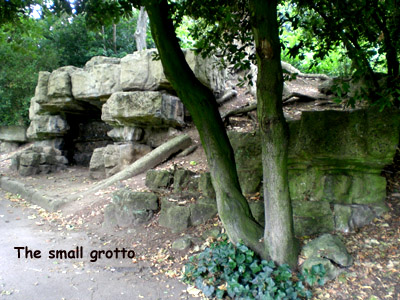 This is clearly too small to have been the Schweppes Grotto site and so it is believed to be an original grotto feature dating from 1865-70. This may well explain Lord Strabolgi's remark in the House of Lords cited earlier indicating more than one grotto at the Festival Pleasure Gardens.
This is clearly too small to have been the Schweppes Grotto site and so it is believed to be an original grotto feature dating from 1865-70. This may well explain Lord Strabolgi's remark in the House of Lords cited earlier indicating more than one grotto at the Festival Pleasure Gardens.
We would be very interested in any information that enables us to verify the above. Please email us at grotto@thespas.co.uk
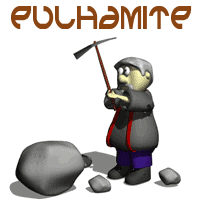
More details of the history of the park and Pulhamite rockwork can be found by clicking the rock smasher left.
Further Reading:
Simmonds D A (1983) Schweppes, the First 200 years, Acropolis US.
Hitching C (2012) Rock Landscapes - The Pulham Legacy, Garden Art Press. Chapter 6.
ADDITIONAL INFORMATION
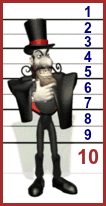

GREAT BRITISH GROTTO GRADING
Click to go to Grotto.Directory home page
Key to the map below:
A - the likely site of the Schweppes Grotto. Gareth Hughes has kindly provided further information verifying the location as follows: the website "Britain from Above", run by English Heritage, contains the Aerofilms archive and includes a large number of photos of the Festival Pleasure Gardens at Battersea. Several show the Schweppes Grotto, including some of it under construction. Subscribers (it's free) can also zoom into the pictures, which show quite a lot of detail of the structure and confirm its appearance and location in relation to the other known features of the gardens - it seems to have been largely an above-ground construction, masquerading as a rocky hill
B - the Water Cascade and rocks
C - the small grotto
D - the Pump House
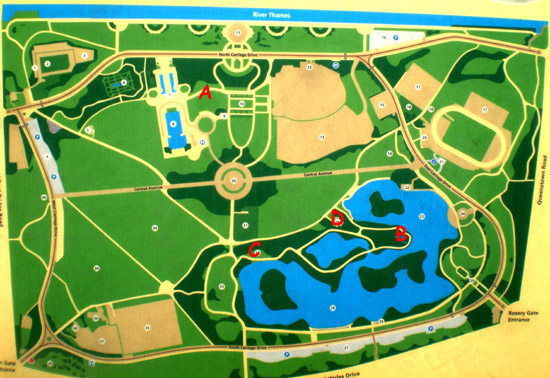
CONSTRAINTS
Open set times only
FACILITIES
Access all Year, Access by Road, Access on Foot, Disabled Access, Free Entry, Grottoes - more than one, Restaurant/Food, Toilets
LANDSCAPE
Park or Garden, Urban
REGION
England - Southern
THE FEATURES PRESENT
+Dark and mysterious chambers and cave like spaces, +External rock structures, either real or simulated, GRADED TWO
|









